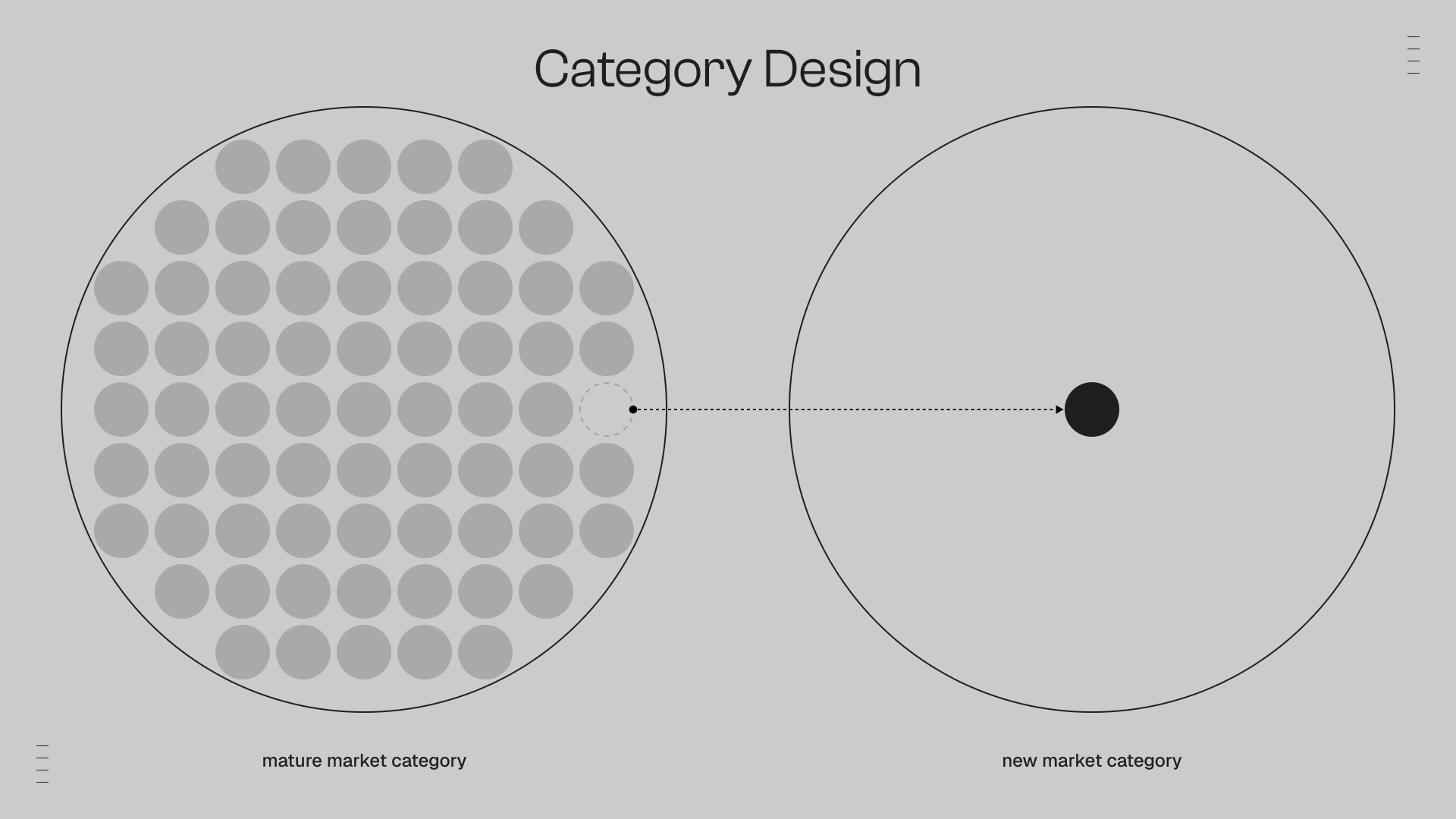
Intro to Category Design
Aug 20, 2025
Modern markets suffer from what I call "the convenience store paradox." For anyone who has ever visited Japan, the sheer number of convenience stores and the breadth of services that they provide are always something that leaves a strong impression.
From the perspective of the consumer, the value provided by convenience stores is amazing. You can do everything from buying food, paying your bills, buying concert tickets and sending packages. But the problem is that every other convenience store offers the same services. When you provide every feature possible and your competitors can too, there is nowhere left to go when it comes to differentiation. This leads to a state where despite providing an excellent customer experience, stores are unable to capitalize on this to create a business advantage and capture more of the market:
- Race to Feature Parity: Every store offers the same comprehensive services—food, bill payment, concert tickets, package delivery etc
- Circumstantial Choice: Customers choose based on proximity, not preference
- No Meaningful Differentiation: When everyone offers everything, no one stands out
This mirrors a pattern that is currently accelerating across most mature markets today. Technology has lowered barriers to entry, AI has simplified execution, and mature markets are increasingly crowded. As a result, feature saturation has eroded meaningful differentiation.
The test: Ask yourself about your favorite convenience store. Would you walk 100 meters past a competitor to reach it? What about 1 kilometer? If the answer is no, circumstance trumps preference—a clear sign of commoditization.
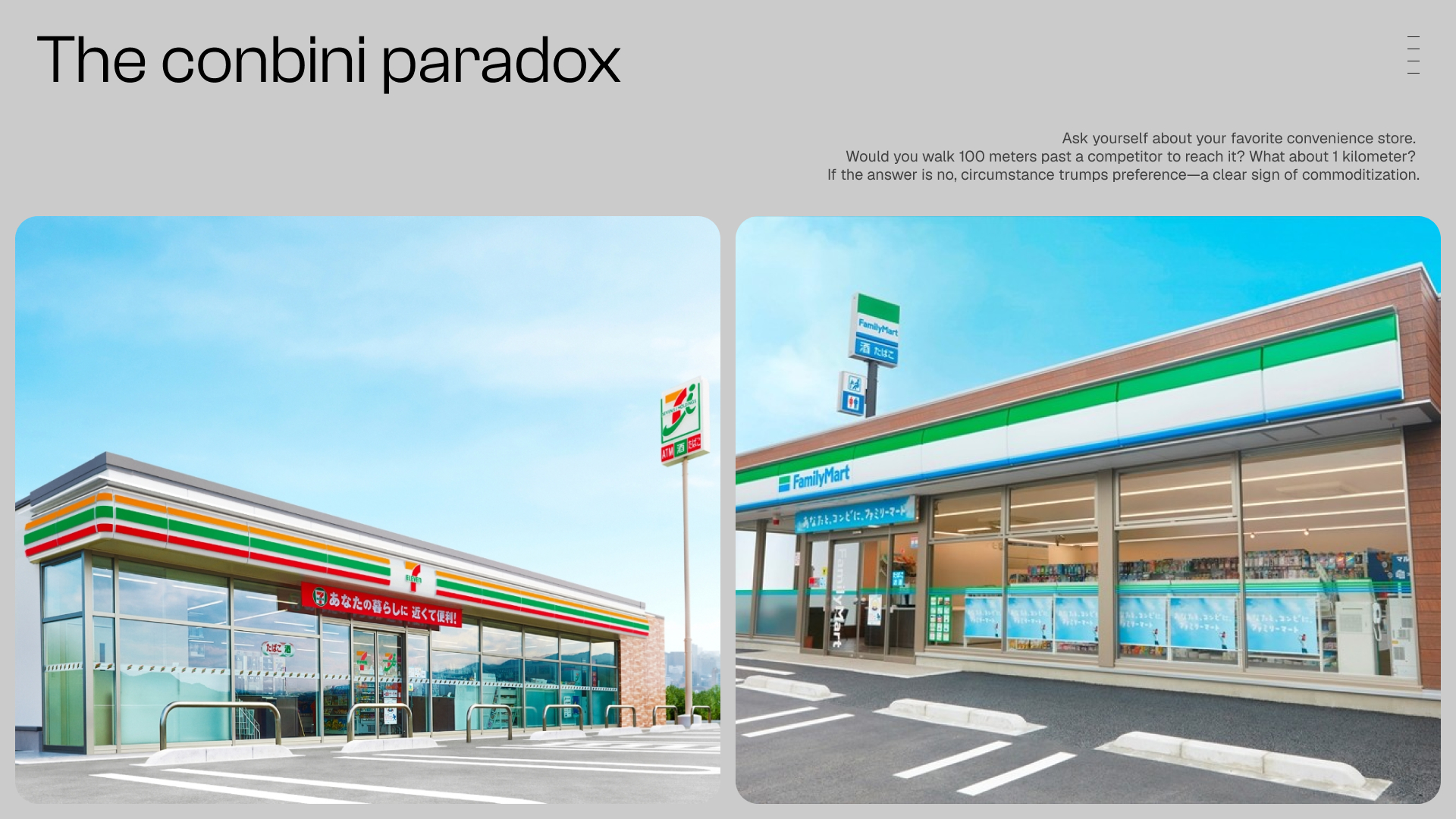
Recently, through conversations with various founders and product people, I've seen many teams struggling with differentiation. While most people building products understand the need to stand out in a crowded market, it's still often overlooked just how powerful of a growth lever it can be when executed well.
When I work with teams to create differentiation through product positioning and strategy, the most common starting point is usually category design. Category design is a business strategy focused on establishing new and unique market categories—and positioning your business as the leader in that space. This is often done by changing the way people think and behave in an existing market and shifting them toward a new direction that benefits your business. As a result, your product offering is seen as a new "category" that differs fundamentally from your competitors. In short, if you can position your product into a new category where no other competitors exist and drive demand for it, you can create an unfair advantage.
Defining Category Design
Category design is a business strategy focused on creating and developing new market categories for products or services, positioning your company as the definitive leader within that category.
Rather than competing in existing markets, category design seeks to:
- Define and dominate new market categories
- Redefine latent consumer needs
- Shift customer perception of value
- Create markets where traditional competitors don't exist
The core principle: If you can position your product in a new category with no competitors and drive demand for that category, you create an unfair competitive advantage.

Classic Examples of Category Design in Action
Before we get into how to execute category design, let's take a look at what it looks like in action to better understand it.
Salesforce is a classic example—introducing the concept of "cloud CRM" as a fundamentally different approach within the crowded CRM space. Founder Marc Benioff also worked to popularize terms like "SaaS" and "No Software" and associate them with Salesforce, helping establish an entirely new market category in which they were the only viable offering.
Starbucks is an older, pre-tech example of successful category design. By introducing the market to the idea of the "third place" and positioning themselves as such, they created a new category rather than simply competing with traditional coffee shops. This concept has been so successful that Starbucks is able to attract customers that have no interest in coffee at all and are simply there for the vibes of the third place.
Airbnb is another disruptive example I wrote about previously, where category design was used to position their products in a new space—distinct from traditional travel accommodations like hotels. Functionally it is not much different than traditional travel accommodation. What's the difference between airbnb.com and Hotels.com? The experience of booking accommodation and the information provided is very similar. However, from the mindset of customers seeking a more authentic travel experience, the perception of these products are very different.
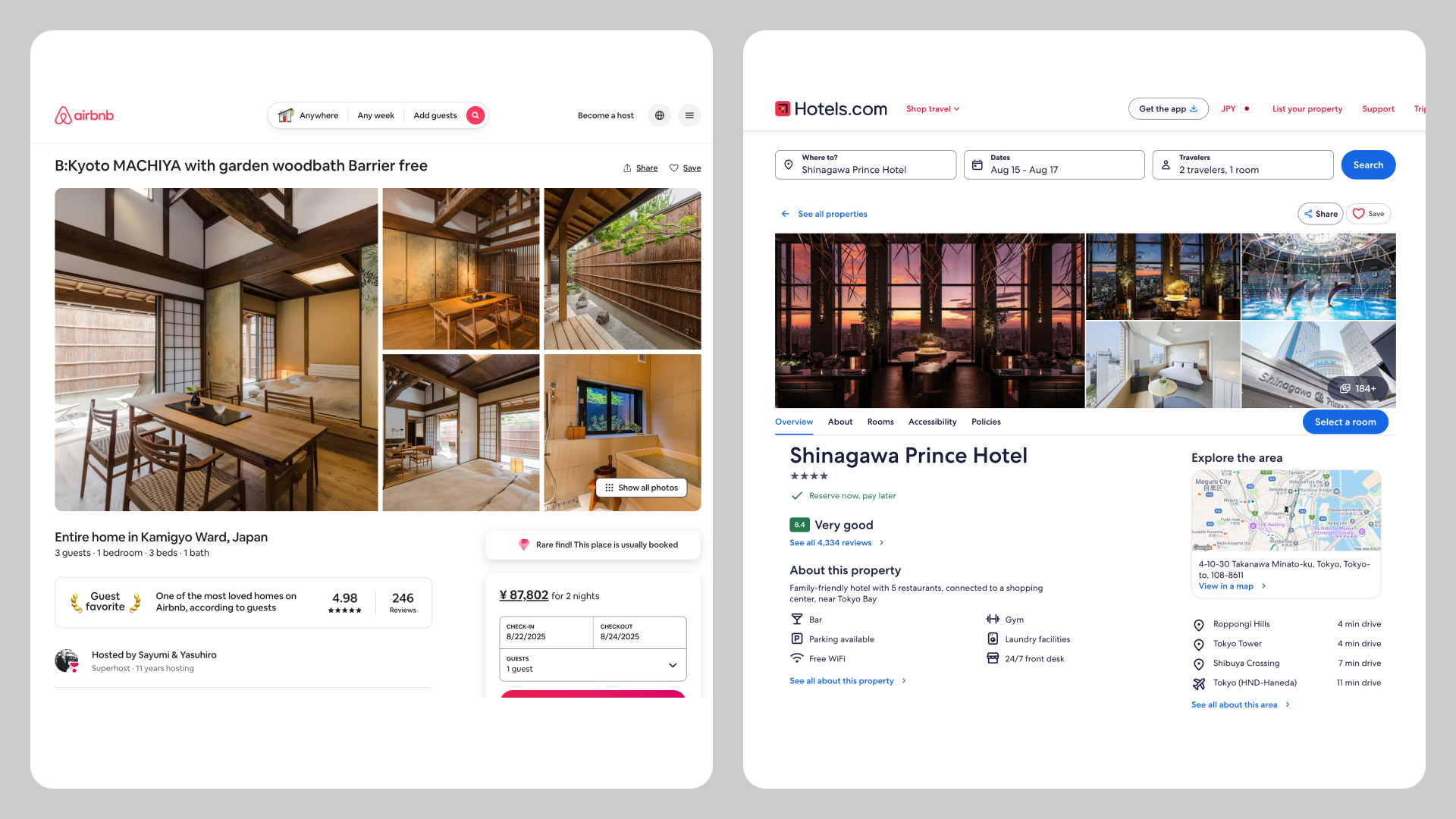
Category design does not require innovative technology or novel features to be executed effectively. Starbucks serves coffee, Salesforce manages customer data, Airbnb books accommodations. The innovation was in how they positioned and framed these familiar functions. This is why category design can be more accessible than traditional product innovation—changing perception often creates more value than changing features. Better yet, this perceptual shift follows a repeatable framework that any team can implement systematically.
The Category Design Framework
Category design operates on a simple principle: changing perceptions changes markets.
Core Objectives
- Challenge Current Thinking: Change how people perceive the existing market category
- Establish New Value: Define a new category that provides superior or different value
- Claim Leadership: Position your business as the undisputed leader of this new category
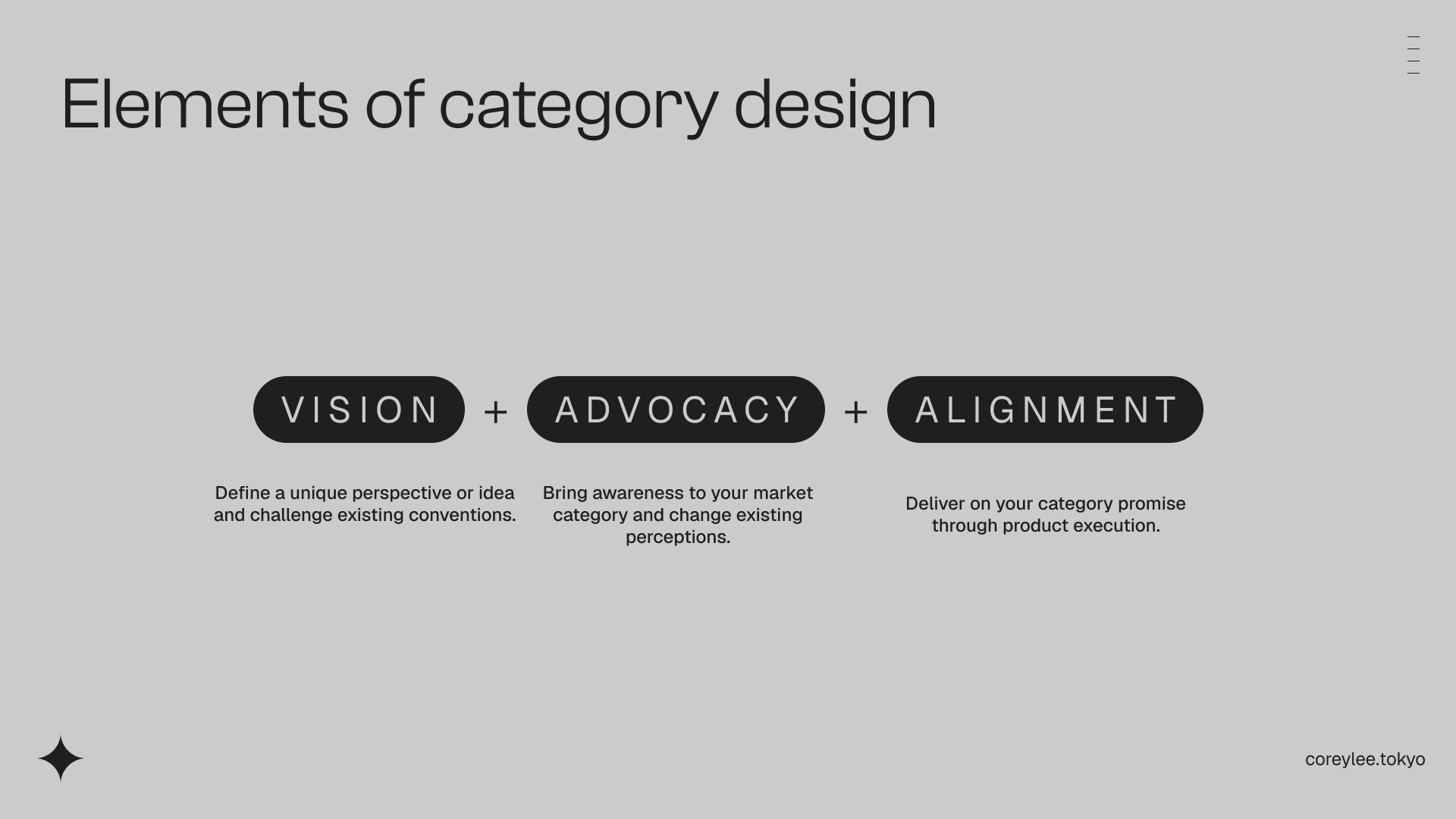
The Three-Part Formula: Concept → Advocate → Align
- Vision: Define a unique perspective or ideal, and challenge existing common sense and frameworks.
- Advocacy: Actively communicate new categories and values to change market and customer perceptions.
- Alignment: Align all products, organizations, and communications with that vision and category.
Part 1: Vision - Define Your Unique Perspective
Vision is about establishing a unique perspective, something that challenges existing ways of thinking and offers a superior or more niche alternative to the current market norm.
Branded Vision
Changing perceptions is often done with a branded vision used to establish market positioning. Think Starbucks's "third place," or Airbnb's "authentic travel." These branded visions are designed to peak interest and trend while creating awareness of their business's unique value proposition through association.
At its core, a great vision is inspiring, aspirational and triggers an emotional response that motivates an audience to seek change. This motivation is what disrupts existing markets, encouraging consumers to choose your product instead of the incumbents.
Here are some ways you can define a vision to drive a new market category:
Research Underserved Niches
- Identify gaps in current market categories
- Find customer segments with unmet needs
- Look for emerging behaviors or trends
Challenge Conventional Thinking
- Question industry assumptions
- Identify what everyone else is getting wrong
- Find a contrarian but defensible perspective
Create a New Mental Model
- Give your category a name
- Define the problem differently
- Establish new success metrics
- Create new language around the solution
Unbranded Vision Through Product Execution
While clearly branded visions are often the most common approach, sometimes it's less about what is said and more about how it's demonstrated by your product. Tools like Linear and Vercel are great examples of changing perspectives through product execution.
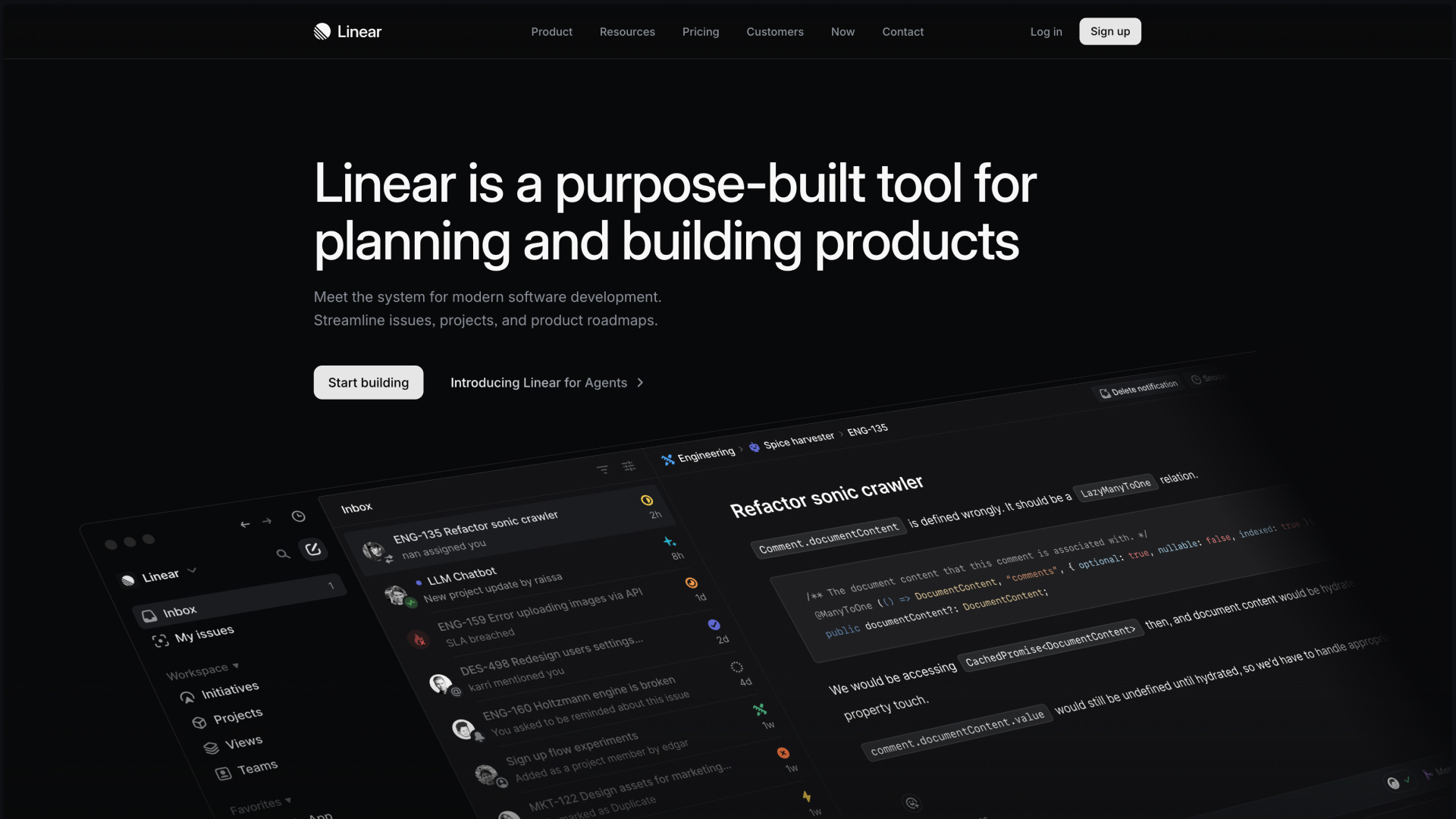
Until recently, developer-focused tools have been clunky, unintuitive, and lack visual polish. The success of AWS is a great example of this utilitarian approach to developer tools. The prevalence of tools that found success despite forgoing investment in design to improve their product experience established the thought model that developers don't care about design. Until recently, many developer tools prioritized pure utility over usability or polish and still succeeded.
Linear and Vercel flipped that. With a design-led approach, they helped establish a new category of tools for design-conscious developers—one in which they're now the clear leaders. Although they don't explicitly brand their vision, it's clear from their product execution that they believe there is a market for design-driven developer tools. Their growth can be attributed to challenging how the existing market thought about the necessity of design in the developer tools market.
Part 2: Advocacy - Building Category Awareness
Advocacy is about marketing your new category, not just your product. Whether you are creating an entirely new category or attempting to become the leader of an emerging one, you need to build awareness of its existence.
Marketing the Category First
Unlike traditional go-to-market (GTM) strategies that focus on the product, you'll need to spend a significant amount of effort raising awareness of the differences between your market and the existing market, convincing potential customers to buy into your new concept.
It may sound inefficient to spend resources on marketing a market, but remember—your market category is your product and your product is the market. If your product is the only one in its category or the clear leader, all your advocacy can be thought of as marketing that leads back to your product.
Defining Advocacy
For most product teams, advocacy may sound like an abstract concept that doesn't have a clear connection to quantitative business goals. In reality, it's much simpler than you might expect: At its core, advocacy is just marketing for ideas. Advocacy is the delivery mechanism for your vision.
Advocacy (noun) The act of actively supporting, promoting, or arguing in favor of a cause, idea, policy, or group — often with the goal of influencing decision-makers, shaping public opinion, or driving social, political, or organizational change.
Just as in marketing, you need to identify your target audience, craft a compelling value proposition, and deliver that effectively to persuade a transaction. With advocacy, the transaction we are looking for is buying into a new idea or way of thinking.
Marketing sells products. Advocacy sells change.
| Marketing | Advocacy |
|---|---|
| Promotes a product or service | Promotes an idea, cause, or policy |
| Aims to persuade customers to buy | Aims to persuade people (or decision-makers) to adopt or support |
| Uses branding, messaging, and targeting | Uses framing, storytelling, and targeted outreach |
| Measures success in sales, market share | Measures success in policy change, awareness, or behavior change |
The Three I's Framework
From my experience, the simplest yet most effective approach to advocacy can be broken down into what I call the three I's:
Inform
Bring awareness to the existence of the new category. Explain what it is, why it is fundamentally different from the current established market. Comparing and contrasting this new category to the existing market gives a reference point from which people can anchor their understanding. Name and brand this new category. Through your advocacy you want to spark discussion and get people to remember this new product category. It's worth workshopping the naming until you find something that is memorable and peaks interest.
Inspire
Don't just tell them what it is, paint a vision of what things could be. Show your audience the potential that they are missing by not buying into this new category. Sell them a compelling outcome.
Initiate
Now that you've got their attention and they're excited about the concept that defines this new category, give them a clear call-to-benefit that leads to your product.
Advocacy in Practice
So what does this look like in practice?
Airbnb: A Better Way to Experience Travel
Let's take another look at how Airbnb advocated for its "authentic travel experience" category. In 2016, Airbnb launched their "Live There" campaign, creating awareness (inform) for the authentic travel experience category. Utilizing multiple mediums and platforms, Airbnb created aspirational visions of what authentic travel experience could provide in contrast to traditional accommodation (inspire). With phrases like "Don't just go there. Live there." and "Belong Anywhere" they clearly framed the desired mindset that differentiated this new market. Phrases such as "Live there. Even if it's just for a night" also served as a call-to-benefit (initiate) leading potential customers to their offering that was clearly aligned to this new category.
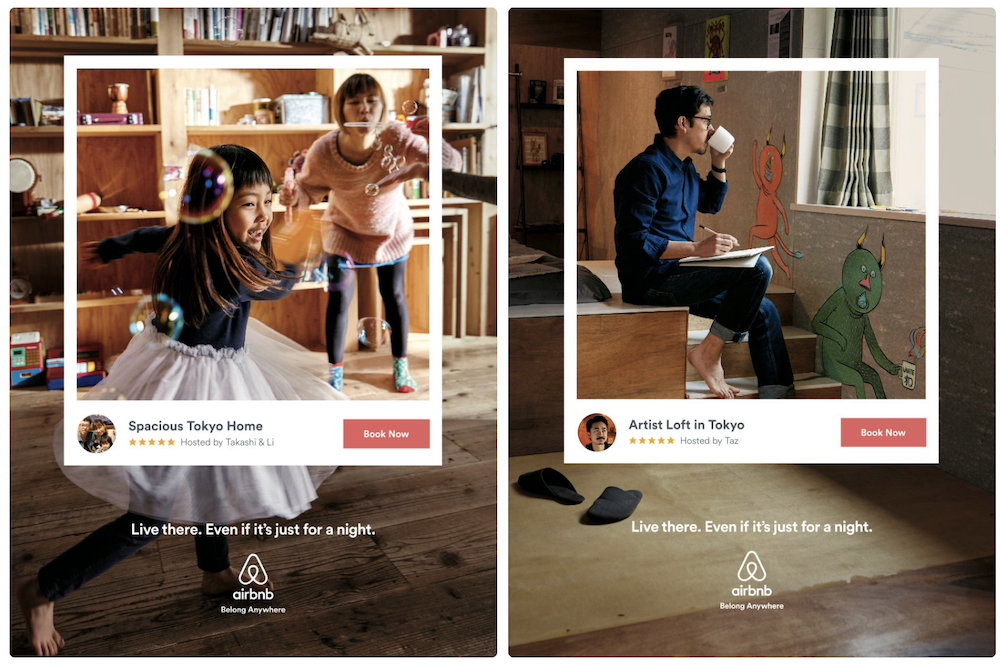
Figma: A Better Way of Working
As a former designer advocate at Figma, I can't talk about advocacy without mentioning how Figma used advocacy to define its product category. While Figma is quickly becoming the de facto tool for product design teams globally, it wasn't always that way.
Over the years, Figma has invested in traditional marketing campaigns like "Nothing great is made alone" as well as the creation of an advocacy team to champion their vision and establish a new market category for collaborative design tools. The phrase "Nothing great is made alone" is a great example of a branded vision that sells an idea of change and leads believers clearly to Figma. In a market where design was traditionally siloed and less collaborative due to the restrictions of file-based tools, Figma drew a line in the sand. They took the position that design should be collaborative by default to achieve greatness. More recently, "Design is everyone's business" captures a similar aspirational vision of the importance of design.
I may be slightly biased, but in my eyes Figma is arguably one of the most successful cases in the current era of effective advocacy contributing to a successful outcome with category design. Throughout its growth, Figma has invested significant resources in selling the vision of collaboration being a better way of working, and as the believers in this vision increase, Figma continues to grow with them.
Part 3: Alignment - Deliver on the Promise
Alignment is about ensuring your product delivers on your category promise. You can have the most compelling category vision and the most effective advocacy campaign, but if your product experience doesn't live up to the expectations you've set, your category design will fail.
Why Alignment Matters
Category design creates expectations. When customers buy into your new category, they're not just choosing your product—they're choosing to believe in a different way of solving their problem. If your product experience doesn't consistently reinforce and deliver on that category promise, you'll lose credibility and customers will revert to familiar alternatives.
Think of alignment as the proof of your category claims. It's where your category positioning moves from marketing message to tangible reality.
Defining Alignment
Alignment is the systematic integration of your category positioning across every aspect of your organization and customer experience. It ensures that every touchpoint, feature, and interaction reinforces your category differentiation rather than contradicting it.
Unlike traditional product development that focuses on features and functionality, category-aligned development prioritizes experiences that reinforce your unique market position.
Experience Alignment Examples
Starbucks: The Third Place Experience
Starbucks demonstrated their third place vision by investing heavily in creating inviting spaces. Their interior decor, ambient music, lighting, Wi-Fi, and location selection all demonstrate the vision of the ideal third place. For a global coffee chain, Starbucks has some of the most impressive store locations—think Shinjuku Gyoen or Kansui Park in Japan. Through these investments, Starbucks made it clear that their product isn't just coffee—it's the third place experience itself.
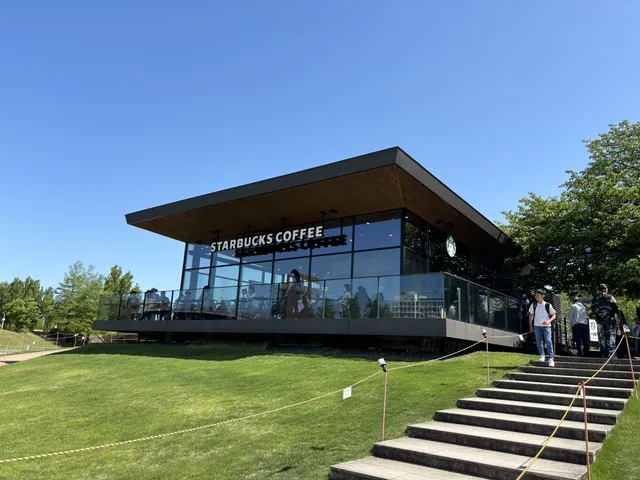
Slack: Conversational Team Communication
Slack aligned around a vision for a less formal and more enjoyable team communication platform. This led to a much more conversational and playful brand compared to most enterprise communication tools. Take their emoji integration as an example—a simple feature that may seem unnecessary in an enterprise communication tool is absolutely necessary for customers that believe in their vision for how communication should be. As a believer myself, the ability to set custom emoji reactions is a non-negotiable feature and completely changes team communication dynamics.
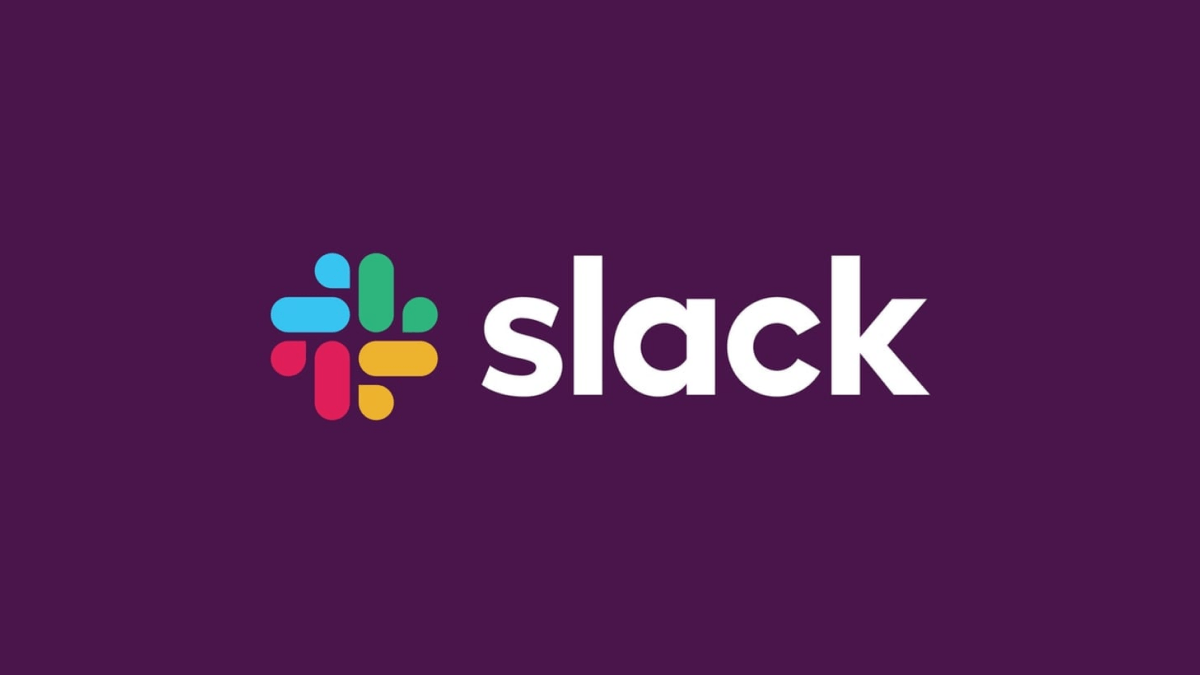
Of course, Slack's promised vision as team communication hub "where work happens" goes beyond emojis and its iconic message chime. Slack built more effective ways to manage communication channels, integrations with numerous other tools, automations and bots that all demonstrated its vision for better teamwork. Notably declaring that "email was broken for team work," going to war with email and resulting in a generation of teams that favor Slack as the primary medium for all internal communication.
Here are some ways you can align your product to your vision:
Product Experience Alignment
- Feature Priority: Build features that reinforce your category position
- User Experience: Design experiences that embody your category values
- Performance Metrics: Measure success based on category-relevant KPIs
Organizational Alignment
- Sales Training: Equip sales teams to sell the category, then the product
- Marketing Consistency: Ensure all messaging reinforces the category
- Customer Success: Support customers within the category framework
Design and Communication
- Visual Identity: Reflect your category position in design choices
- Language: Use category-specific terminology consistently
- Touchpoints: Reinforce the category at every customer interaction
Demonstrating your vision to define a category is just as much about creating features that provide functional value to your believers of your vision as it is about creating the vibes with elements that create emotional response regardless of their tangible value.
The Business Impact of Category Design
Category design creates measurable business advantages that traditional differentiation can't match.
When you successfully create a new category, you own a new market separate from the existing crowd. Starbucks doesn't compete with every coffee shop—people seeking the third place experience aren't comparison shopping, they're choosing whether they want that experience at all.
Category design also grows your total addressable market through advocacy. Figma didn't just take market share from existing design tools; they expanded the market by convincing product managers, developers, and stakeholders who never used design tools before to become collaborative design believers.
Most importantly, customers drawn in through your category vision become believers, not just users. They don't just buy your product—they evangelize your entire way of thinking, becoming advocates who drive organic growth in ways traditional marketing can't match.
Category design isn't just a growth strategy—it's how you build a business that transcends the commodity trap. In a world where circumstance increasingly trumps preference, category design creates genuine preference that drives intentional choice.
Getting Started with Category Design
If you're competing primarily on features or finding that customers choose you by circumstance rather than preference, category design might be your path forward. The framework is systematic: develop your unique vision, advocate for the category through marketing and thought leadership, then align your entire product experience to deliver on that promise.
The companies that will thrive are those that create new categories rather than compete in existing ones. Category design isn't just a growth strategy—it's how you escape the commodity trap and build genuine customer loyalty in an increasingly crowded market.
If you're ready to break out of the commodity trap and create a category where you're the clear leader, I'd love to help you get started. I work with teams to develop their unique category positioning and execute the vision-advocacy-alignment framework that drives meaningful differentiation and growth. Set up a call to explore how category design could transform your business.